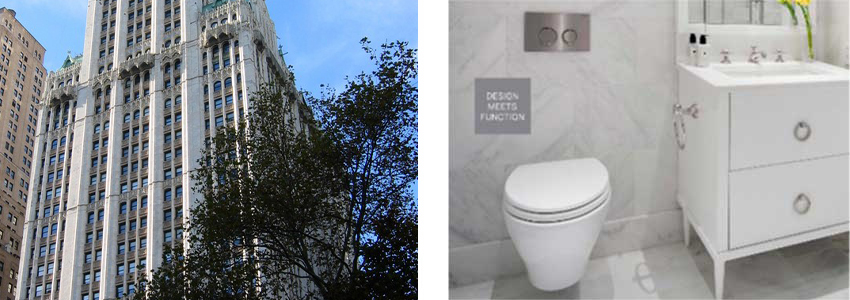Multifamily Buildings with Multiple Design Criteria
Water Efficiency
An in-wall toilet system offers special water efficiency benefits in a multifamily building. According to the U.S. Environmental Protection Agency (EPA), the highest percentage of water use comes from the domestic restroom. This makes the design of flushable toilets particularly important. In this case, it is the design of the flow mechanism and the controls that actuate it which are critical.
Traditionally, floor-mounted toilets with a manual flush have been the norm in many multifamily settings. However, toilets with dual-flush controls are becoming more common, since they allow the user to determine how much water is used for each flush appropriate to the need. Commonly, there are two choices for a standard and reduced water flow per flush, instead of being limited to only one standard choice. With such dual-flush technology built in, a household can reduce their water usage by thousands of gallons of water per year. In-wall toilet systems typically include such dual-flush technology activated by touch (or touchless) panels flush-mounted on the wall above the toilet. This provides a clear, elegant solution for the flush controls that help produce the dramatic water savings.
In-Wall Design
While some may think that a high-performance toilet needs to look clinical or austere, the reality is that there are contemporary design alternatives. That means architects do not have to lose their design concepts to achieve critical performance features. Rather, there are innovative products for bathrooms that meet the demand for sanitation, safety, and sustainability while also providing a high level of design. In order to accommodate a range of different project types, there are multiple fixture options to bring a design vision to life. Beyond these aesthetic benefits, there are also clear space savings achieved by recessing the toilet tank system into the wall, allowing for more usable space in restrooms in many cases.
In-Wall Performance
In addition to better water control that is available from dual-flush actuators, in-wall systems are a reliable and high-quality solution for designing contemporary bathrooms that meet the demands of all involved. Overall sanitation and safety are achieved by having less of the toilet system exposed and the bowl raised up from the floor. This adds to the comfort and convenience for users as well as ease of cleaning. In terms of maintenance, all working parts remain easily accessible, although the high reliability of this type of unit reduces the need for maintenance crews to access it in the first place. Commonly, the support frame is based on solid steel construction with a seamless, one-piece tank made of durable, leak-free, high-density polyethylene. Units are commonly tested and proven to support up to 880 lbs. (400 kg) without deforming the frame or the wall.
Together the in-wall systems and wall-mounted flush actuators are clearly greater than the sum of their parts in terms of the benefits provided for building owners and occupants.CONCLUSION
Creating well-designed multifamily housing is a multifaceted task. Fenestration is required in all buildings to provide views and daylights but still achieve targeted thermal performance. Interiors need to be attractive and durable, including the interior of elevators. Innovative materials can be used to enhance the building exterior and interior. Bathroom designs need to be easy to clean and space efficient. Large buildings require expansion joints to protect against inevitable movement. The strategies discussed in this course can help architects and designers address these multiple design criteria to meet the needs of the building owner, the occupants, and the environment.
Peter J. Arsenault, FAIA, NCARB, LEED AP is a nationally known architect and a prolific author advancing positive acoustical experiences through better building design. www.pjaarch.com, www.linkedin.com/in/pjaarch




